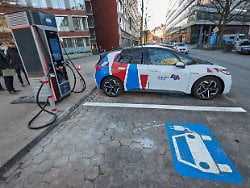Monday, January 03, 2022
Dare to take the “clear cut”
What purchase incentives are needed for e-cars?
The traffic light coalition wants to see at least 15 million fully electric cars on German roads by 2030. In order for the funding to withstand the next stages of climate protection, the consumer association is calling for more targeted incentives – such as a functioning used car market and nationwide charging networks.
There should be a lot more electric cars on German roads – and they will continue to do so with a financial boost from the state. But the new traffic light coalition consisting of the SPD, FDP and the Greens wants to give the funding a stronger climate protection orientation soon. The consumer advice centers are calling for significantly more targeted purchase incentives.
“I would encourage the federal government to take a clear line here,” said the head of the federal association (vzbv), Klaus Müller. Even more should be done with the charging network. Müller said: “You don’t have to subsidize every luxury car from the state, even if it’s an electric car.” Purchase premiums should only be given for list prices below 40,000 euros – up to now, there has been an upper limit of 65,000 euros for the basic model.
Trust in e-cars needs to be strengthened
“We urgently need a functioning used car market for electric cars,” explained the consumer advocate. “And that should be the smaller and medium-sized cars in particular.” Many who cannot or do not want to buy a new car are dependent on it. The condition of the batteries is an important point with a view to possible follow-up costs, according to a vzbv position paper. Buyers of used cars would therefore have to receive reliable, standardized information on the battery’s “state of health”.
In order to increase confidence in used e-cars, the costs of testing batteries could also be subsidized. Müller emphasized: “You should only support electric cars that can be proven to have an environmental impact.” This mainly affects hybrid models with combined drives, which are driven less electrically and more with traditional fossil fuels.
Federal Minister of Economics Robert Habeck has already announced a realignment from 2023. In the future, only e-cars that have “proven to have a positive effect on climate protection” are to be funded, according to the coalition agreement. This should be determined by the proportion of electric driving and the minimum electric range of the models – specifically, a greater electric distance of 80 kilometers is mentioned. The current grants were recently extended again until the end of 2022. In the new year there is an “innovation bonus” of up to 9000 euros for purely electric cars and up to 6750 euros for hybrids that are charged with a plug (plug-in).
Expansion of the charging network is still lagging behind
The aim of the traffic light coalition is at least 15 million fully electric cars by 2030. At the beginning of 2021, according to the Federal Motor Transport Authority, there were 309,000 pure electric cars, plus 280,000 plug-in hybrids. However, new registrations increased significantly in 2021, thanks in part to increased purchase premiums. The consumer advice centers are demanding speed with the further changeover. Until a relatively short time ago, many manufacturers were of the opinion that the mobility of the future would be increasingly heavy, faster and more energy-guzzling. “That was wrong,” said Müller. Now everyone would have actually turned things around.
The expansion of the charging network must also move forward. Sometimes there is a jumble of payment systems and prices, which does not contribute to simplification and reliability. And e-car buyers need security not to be stranded on vacation, on a business trip or when visiting another federal state. The automotive industry is also putting pressure on this. “The charging infrastructure must run ahead of the e-car fleet,” said the President of the Association of the Automotive Industry, Hildegard Müller: “This is the only way we can gain consumer confidence and encourage people to invest in an electric car.” Germany is extremely lagging behind in terms of expansion. “In order to actually be able to achieve the number of e-cars that the federal government is planning, around 2000 new public charging points would have to be installed every week – in fact there are only 300.”
Long loading times take some getting used to
The Association of International Motor Vehicle Manufacturers stated that after electric cars had made their market breakthrough, it was now a matter of continuing the positive trend. President Reinhard Zirpel warned against a “too strong meltdown” of the purchase premium in the coming years. The government should also consider continuing beyond 2025 – and prioritizing simpler rules when reforming sales promotion. Depending on the purchase price, type of drive and lease term, there are currently 16 subsidy rates. “If funding becomes more and more complicated and many car buyers no longer understand it, then fewer electric cars will hit the streets. That would be bad for the climate.”
Consumer advocate Müller then generally sees further acclimatization processes: “For many, it is still difficult to imagine that it is no longer the five minutes of filling up with petrol or diesel – but maybe 20 or 30 minutes of double coffee break and more when charging the car.”
